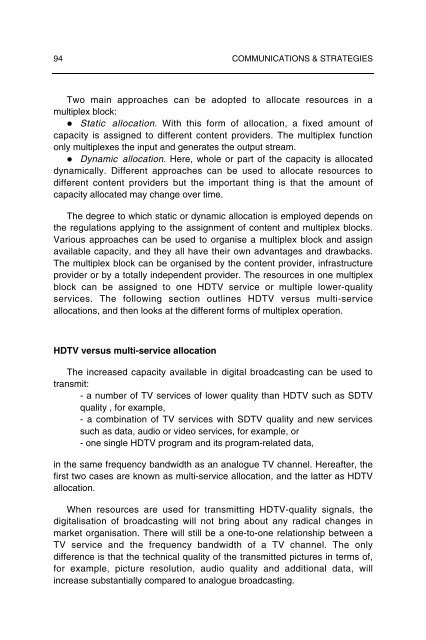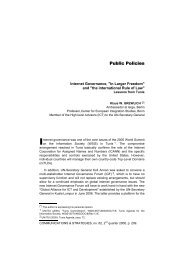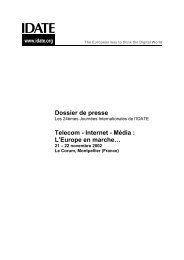Digital Terrestrial Broadcasting: Innovation and Development or a ...
Digital Terrestrial Broadcasting: Innovation and Development or a ...
Digital Terrestrial Broadcasting: Innovation and Development or a ...
You also want an ePaper? Increase the reach of your titles
YUMPU automatically turns print PDFs into web optimized ePapers that Google loves.
94 COMMUNICATIONS & STRATEGIESTwo main approaches can be adopted to allocate resources in amultiplex block:• Static allocation. With this f<strong>or</strong>m of allocation, a fixed amount ofcapacity is assigned to different content providers. The multiplex functiononly multiplexes the input <strong>and</strong> generates the output stream.• Dynamic allocation. Here, whole <strong>or</strong> part of the capacity is allocateddynamically. Different approaches can be used to allocate resources todifferent content providers but the imp<strong>or</strong>tant thing is that the amount ofcapacity allocated may change over time.The degree to which static <strong>or</strong> dynamic allocation is employed depends onthe regulations applying to the assignment of content <strong>and</strong> multiplex blocks.Various approaches can be used to <strong>or</strong>ganise a multiplex block <strong>and</strong> assignavailable capacity, <strong>and</strong> they all have their own advantages <strong>and</strong> drawbacks.The multiplex block can be <strong>or</strong>ganised by the content provider, infrastructureprovider <strong>or</strong> by a totally independent provider. The resources in one multiplexblock can be assigned to one HDTV service <strong>or</strong> multiple lower-qualityservices. The following section outlines HDTV versus multi-serviceallocations, <strong>and</strong> then looks at the different f<strong>or</strong>ms of multiplex operation.HDTV versus multi-service allocationThe increased capacity available in digital broadcasting can be used totransmit:- a number of TV services of lower quality than HDTV such as SDTVquality , f<strong>or</strong> example,- a combination of TV services with SDTV quality <strong>and</strong> new servicessuch as data, audio <strong>or</strong> video services, f<strong>or</strong> example, <strong>or</strong>- one single HDTV program <strong>and</strong> its program-related data,in the same frequency b<strong>and</strong>width as an analogue TV channel. Hereafter, thefirst two cases are known as multi-service allocation, <strong>and</strong> the latter as HDTVallocation.When resources are used f<strong>or</strong> transmitting HDTV-quality signals, thedigitalisation of broadcasting will not bring about any radical changes inmarket <strong>or</strong>ganisation. There will still be a one-to-one relationship between aTV service <strong>and</strong> the frequency b<strong>and</strong>width of a TV channel. The onlydifference is that the technical quality of the transmitted pictures in terms of,f<strong>or</strong> example, picture resolution, audio quality <strong>and</strong> additional data, willincrease substantially compared to analogue broadcasting.







